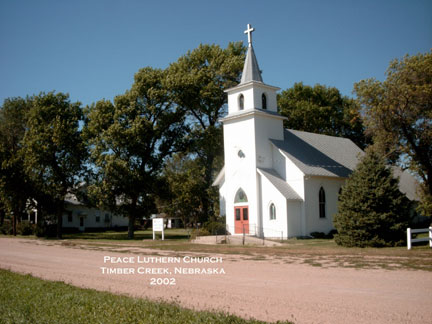
Timber Creek
Belgrade, Nebraska
Fullerton, Nebraska
November 6, 2002
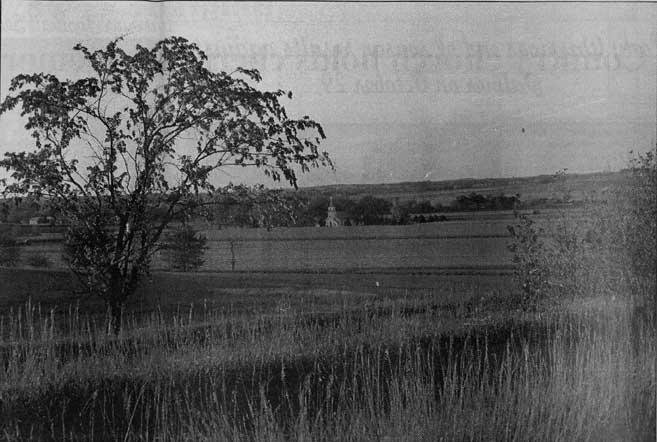
German beginnings
![]() The church was organized in 2898 by German settlers who located in the area.
The church was organized in 2898 by German settlers who located in the area.
Services were first held in a small schoolhouse in South Branch Township. As numbers increased, worshippers gathered at the Red Wing School.
![]() In 1907, C. D. (Carl) Hellbusch sold five acres of land, approximately seven miles southwest of Belgrade, for $180 for a church building site and cemetery. The church was built mainly with volunteer labor for about $2,000.
In 1907, C. D. (Carl) Hellbusch sold five acres of land, approximately seven miles southwest of Belgrade, for $180 for a church building site and cemetery. The church was built mainly with volunteer labor for about $2,000.
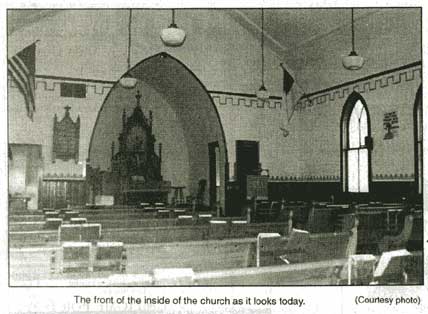
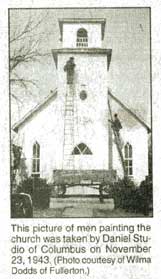
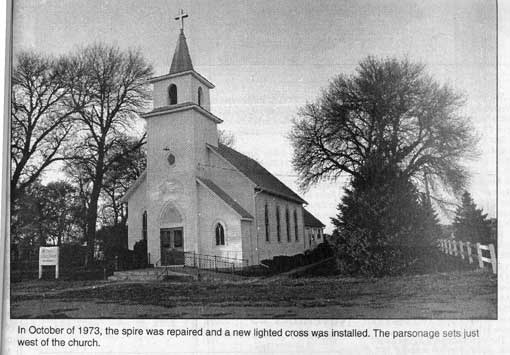
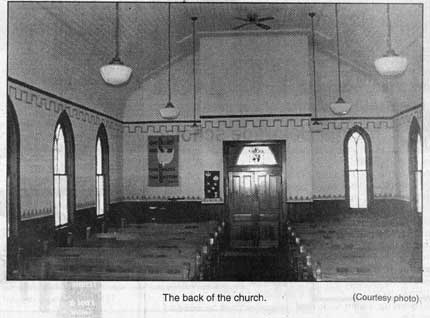
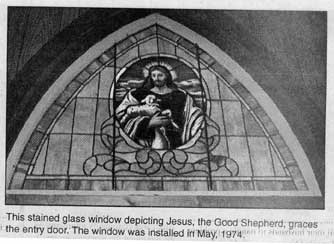
Early records show that after the service: pastors and members of the parish went to the area of the new church, which was then dedicated as God's Acre. The name of the new church is German Evangelical Lutheran Peace Church. The Lord's house is located at the southeast corner of the Charley (C.D.) Hellbusch farm.
Two and a half acres were used to build the church yard and the cemetery, and two and a half acres reserved for building the parsonage. Surface area of the church was 28x40 feet with a tower of 50 feet high.
Known as "one of the most beautiful buildings in the country" the inside decor cost $300 and the organ $100.
A potbelly stove stood in the center of the church. Early members reported that people occupying pews close to the stove were roasting on one side and freezing on the other. "In early times, the women would sit on the east side of the church, and the men on the west," Ella Tschudin Ostrander of Belgrade recalls. "The women would keep an eye on the horses tied on the east side of the church. Sometimes they would have to tell their husbands to handle a problem of tangled harnesses or fighting." Segregated seating continued until the late thirties.
As the years passed, German language services became less frequent and by April, 1939, were held only once a month and finally discontinued in the early fifties.
In 1923, the women of the church organized a Ladies Aid. Monthly meetings began with Bible studies, followed by a business meeting and weekly church cleaning assigned to individuals.
"When I became active in Ladies Aid, I was continually impressed by the gumption the women's group showed in tackling carpentry and maintenance projects," Wanda Ahlers of Belgrade said. " One of the most ambitious was stripping and refinishing the pews."
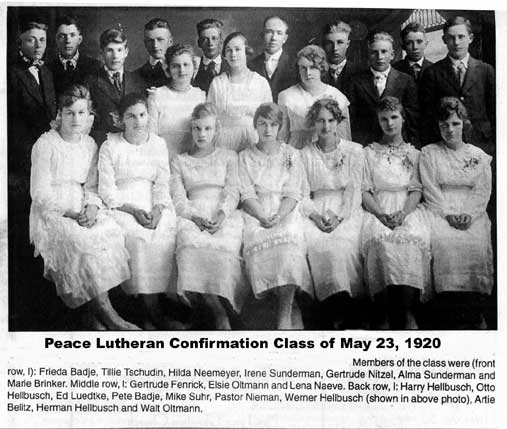
Some members recall the addition of indoor bathrooms with laughter: "We didn't have indoor plumbing. The outside privvy was northeast of the church, where the basketball court is now. We had clear windows in the church then, so everytime you had to go outside to use the bathroom, you always felt like everybody was watching you."
Richard and Donna Lou Hellbusch also donated memorial money to purchase Krinkglass colored panes to replace the clear glass windows on the east and west sides of the church. They were installed in October of 1979 in memory of the Hellbusches' daughter, Debra, who died in 1978 from medical complications.
A bequest from longtime member, Leona Ahlers, along with fundraisers, provided permanent siding on the building in 1996. Over the years memorial funds have provided the church with needed items..
From pews and paint to sidewalks and shingles, members have continued to keep the buildings and grounds in top condition.
Wilma Dodds of Fullerton, who grew up in Timber Creek and later farmed in the area with her husband Harold, reminisced: "My parents, Herman and Martha Schweitz, were married there, and I was baptized, confirmed and married there, too. My folks were caretakers of the church. Every Saturday they faithfully cleaned, without pay."
Our three sons, seven of our eight grandchildren and two great-grandchildren were baptized at the baptismal font my parents gave to the church in memory of my brother Raymond who was killed in the war. Six of my grandchildren were also confirmed there."
"I remember glancing out the windows of the sanctuary on Sunday mornings and looking at the corn growing nearby," she continued. "Even now, when I say the Lord's Prayer in church - any church - I still see Karl Hoffman's corn standing in the fields."
The bell Lytle spokeof was a 1,000 pound bell installed in 1915. During that period, it was the practice to ring the bell at 6 p.m. Saturday evening as a reminder of worship the next morning. Some years the bell was tolled to bring the news that a member of the congregation had died.
Some of Rheva (Rathje) Wagner's favorite memories include "dressing up in a new dress, hat and shoes for East each year. Christmas Eve programs and looking forward to the brown bag of candy and fruit" and "coming over the hill above the church on any given day and lookingdown at the beautiful church and valley as well as the Hoffman farm." Wagner now resides in Glendale, Arizona.
For Jane Ostrander Swartz of Fullerton, even the sight of a Hershey bar brings sweet nostalgia. "The two weeks of Bible school gave children an opportunity to study, memorize, and play certain games. Rev. Schettler gave a Hershey candy bar to all students on the last day."
Roger Hellbusch of rural Belgrade, lifetime member of Peace Lutheran, recalls an amusing boyhood memory: "Lewis Fittje and I spilled the collection plate one Suinday, and got a really diry look from Deacon Bertus Twiestmeyer. It had a lot of change in the plate so when ithit the floor, it really made a lot of noise." Roger and his wife, Janet, have five sons. All were baptized there, as well as their four granddaughters.
Sunday services were switched to Saturday evening services this past summer, due to the schedule of the pastor, Rev. Norman Porath of Columbus, who also leads worship services in Schuyler on Sunday. Attendance at Saturday services dwindled to often as few as six members, leading to the recent decision to suspend services. The parsonage just west of the church has been rented and occupants keep a watchful eye on the church building.
"We've heard many comments from people how peaceful our church looks when you drive down the hill from the south," Roger and Janet Hellbusch noted, "such an appropriate name - Peace."
Although members hope to hold services once again, perhaps those who had attended that first dedication 104 years ago sensed the wave of the future, when that momentous occasion closed with these final words: "Long stand the building to the gloory of the Lord...but long live the soul.